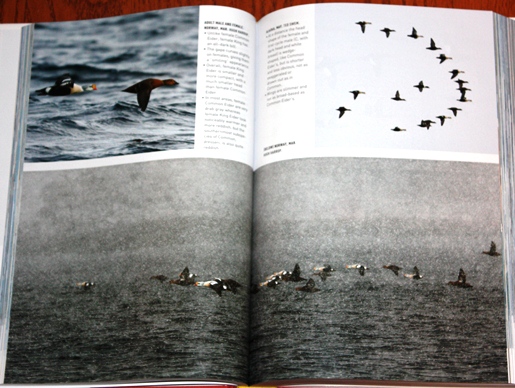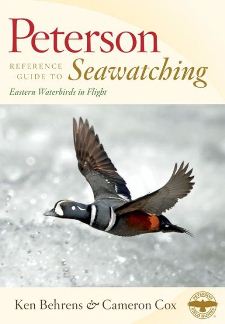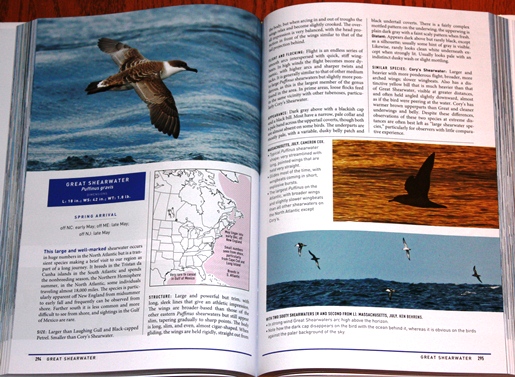Reviewed by Grant McCreary on December 1st, 2013.
You’re standing on a beach, looking out over the Atlantic. Some birds, just dark shapes at this distance, wing past. “Surf Scoters” proclaims the birder next to you. Huh? How could he tell they were scoters, much less which one? “With a single Black Scoter in with them”, he amends. How is that possible?!
Ah, but it is possible; this is just a different type of birding – seawatching. As Behrens and Cox define it, seawatching is “the observation of migrating waterbirds in flight”. This is not limited to the ocean, but can take place on any body of water or even dry land. But no matter where you seawatch, it’s a daunting challenge. These birds will likely be quite a distance away and moving quickly. Regular field guides just won’t cut it in such situations. Enter Peterson Reference Guide to Seawatching: Eastern Waterbirds in Flight.
Covering 111 species from 15 families, this guide includes most of the waterbirds that you can see migrating in the eastern half of the Unites States and Canada. It includes such groups as waterfowl, cormorants, loons, tubenoses, alcids, gulls, and terns. Note that it does not include some birds that are usually thought of as waterbirds, like waders (as most of them migrate at night) and shorebirds (nocturnal migrants, and also because they are well covered in The Shorebird Guide).
Each of the accounts includes the standard elements: text, range map, and illustrations. The latter is provided by some fantastic photographs. As you would expect, we get some great up-close and sharp images of these birds, some even full-page. This, combined with a great layout, make this an attractive book to look at, so much so that it would be easy to mistake for an art book. But even better than these glamour shots, at least in terms of identification, are photos that you don’t usually see printed in books, where the birds are distant or in bad lighting. In other words, they are shown as you see them in the field. The photo captions tell you what to look for, focusing not just on color but structure, flight style, and even flock structure. My favorite pictures are those that contain many birds of multiple species, allowing you to compare and differentiate between similar birds. The captions also include location, month, and photographer.
The text incorporates the following:
- Dimensions – average length and wingspan (in inches) and weight (in pounds)
- Arrival Dates – average spring and fall arrival dates for different locations
- Introduction – information that doesn’t fit elsewhere, such as distribution and calls
- Size – compared against other species
- Structure
- Flight and Flocking
- Appearance – broken down by distinct plumages; ends with a description of how it looks at a distance
- Similar Species
The text, including (especially) the captions, is worth reading. It includes identification information that you won’t find in standard field guides, particularly in regard to non-plumage-based field marks. While not exactly a riveting read, the authors at least attempt to keep it fairly snappy and interesting. Here’s their description of a flying Dovekie, for example:
There is no discernible break between the head and body, so distant Dovekies look like winged, oval-shaped blobs.
The text is sometimes even cheeky, such as this caption for a shot of Atlantic Puffins flying beside a boat:
Identification purists look away – this photo serves no purpose but to add some color and interest!
However, given the large number of species covered, Seawatching doesn’t go into as great a detail as some family-specific guides. For instance, it mentions that the Black-capped Petrel is variable and that multiple species could be involved, but it just briefly describes and does not illustrate these differences. For that, you will still need Petrels, Albatrosses, and Storm-Petrels of North America. And, of course, there isn’t nearly enough room here to do gulls justice.
The range maps are very nicely done; they’re big, zoomed in appropriately, and annotated with additional information on distribution and vagrancy.
Aside from the species accounts, there’s a 20-page introduction that’s worth reading because it describes the general approach that you need to take for seawatching. At the end of the book is an overview of 47 seawatching sites, spanning from Newfoundland to South Padre Island, from Cape Cod to the Great Lakes. The site descriptions range from a few paragraphs to a few pages, depending on how much is known about the site’s seawatching potential.

I love the bottom picture of King Eiders. It looks more like a Lars Jonsson painting than a photograph.
Seawatching seems to have been heavily inspired by The Shorebird Guide and Hawks in Flight. Two features used here – photos of mixed flocks and captions that ask questions (with answers in the back) – are reminiscent of the former. The mixed-species photos work great, and are just as essential here as in the shorebird book. However, the questions aren’t handled as well here (fewer of them, and not quite as helpful), but they still serve their intended purpose of encouraging the reader to look closer and learn more from the photo.
The influence of Hawks in Flight is harder to see, but even more critical. Like that landmark guide, Seawatching focuses on what you can actually see in the field, which is probably not a plumage-based field mark. But more importantly, Behrens and Cox hope that their guide “opens a doorway to seawatching” in the same way that Hawks in Flight made hawk watching accessible to all. They succeeded.
Recommendation
Peterson Reference Guide to Seawatching: Eastern Waterbirds in Flight is one of those guides that you don’t know you need until it’s published. I’d never really thought about seawatching before, now I’d love to try it out. But this guide is useful even if you won’t be seriously seawatching – we’re all going to encounter flying ducks, gulls, terns, and other waterbirds while birding. And since many of the birds covered have wide distributions, birders in the western half of the continent – or, for that matter, Western Europe – should also seriously consider Seawatching, despite the title.
Disclosure: I get a small commission for purchases made through links in this post.
Buy from NHBS
(based in the U.K.)
Disclosure: The item reviewed here was a complementary review copy provided by the publisher. But the opinion expressed here is my own, it has not been influenced in any way.







[…] http://www.birderslibrary.com/reviews/books/advanced/peterson_reference_guide_seawatching_eastern.ht… […]